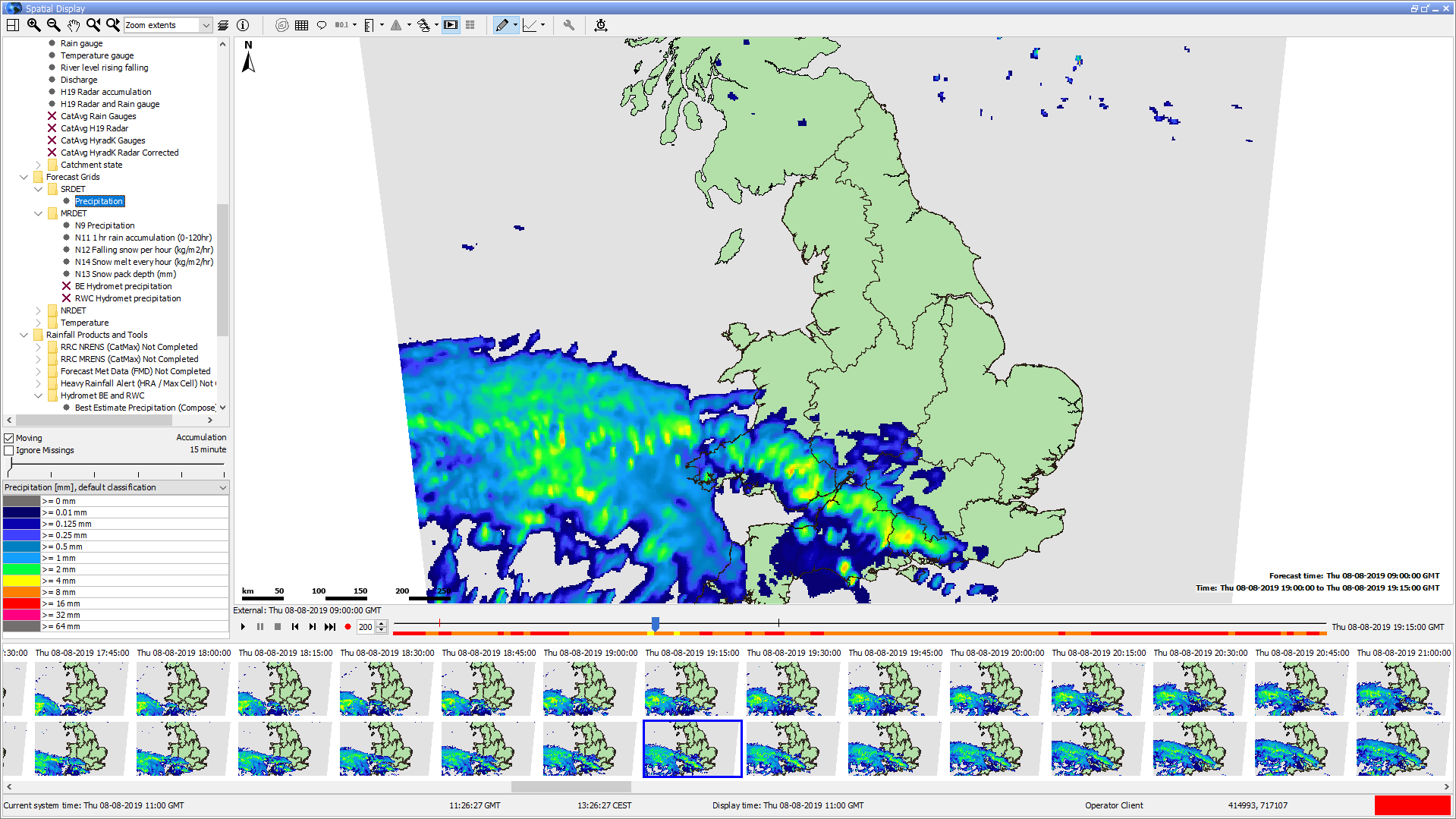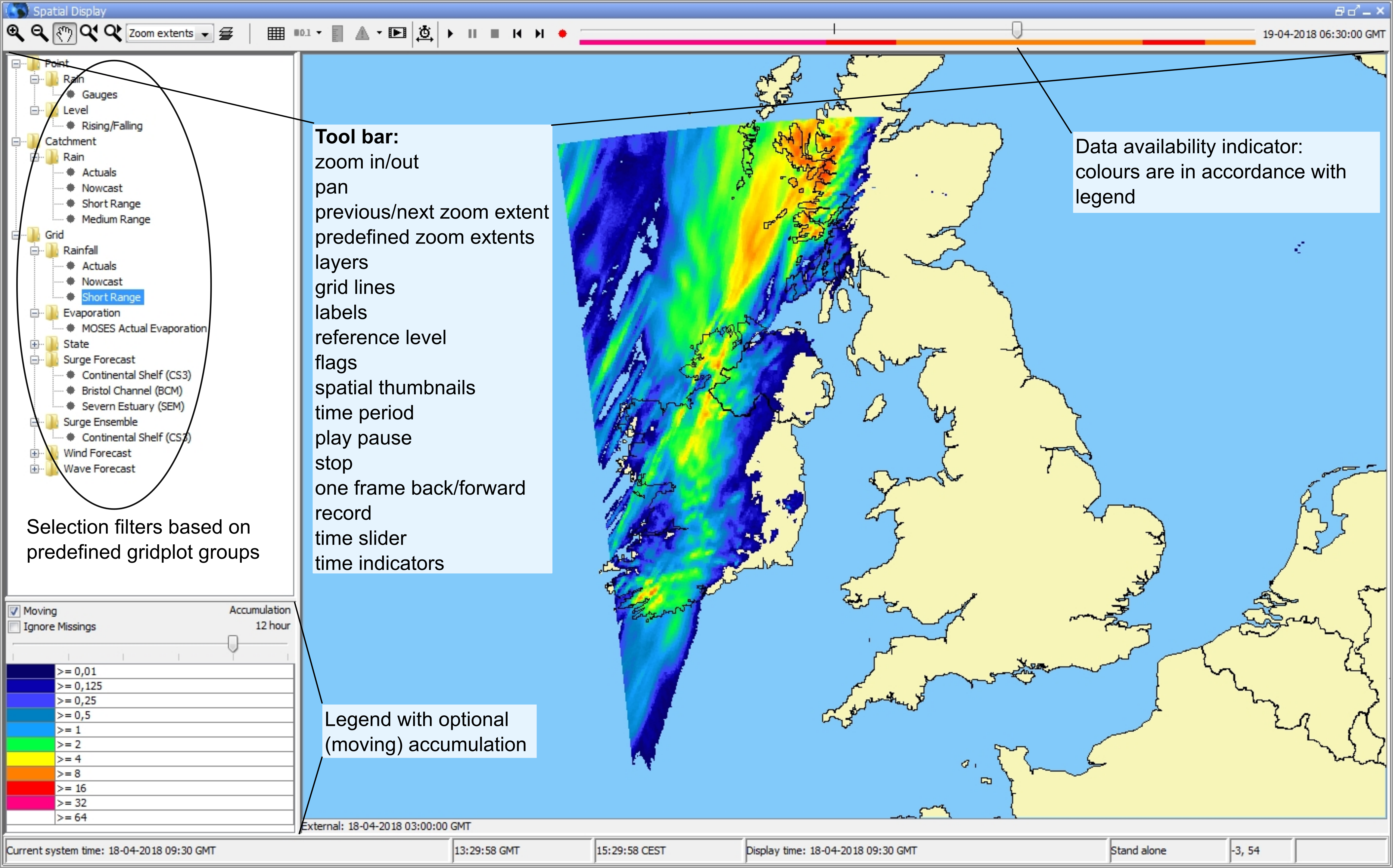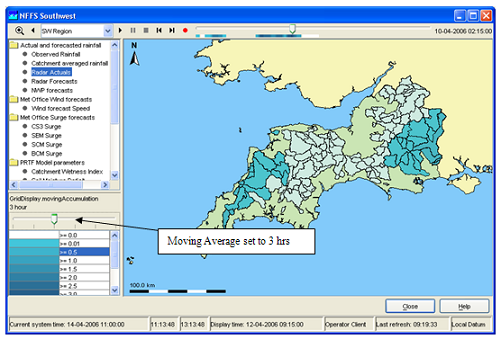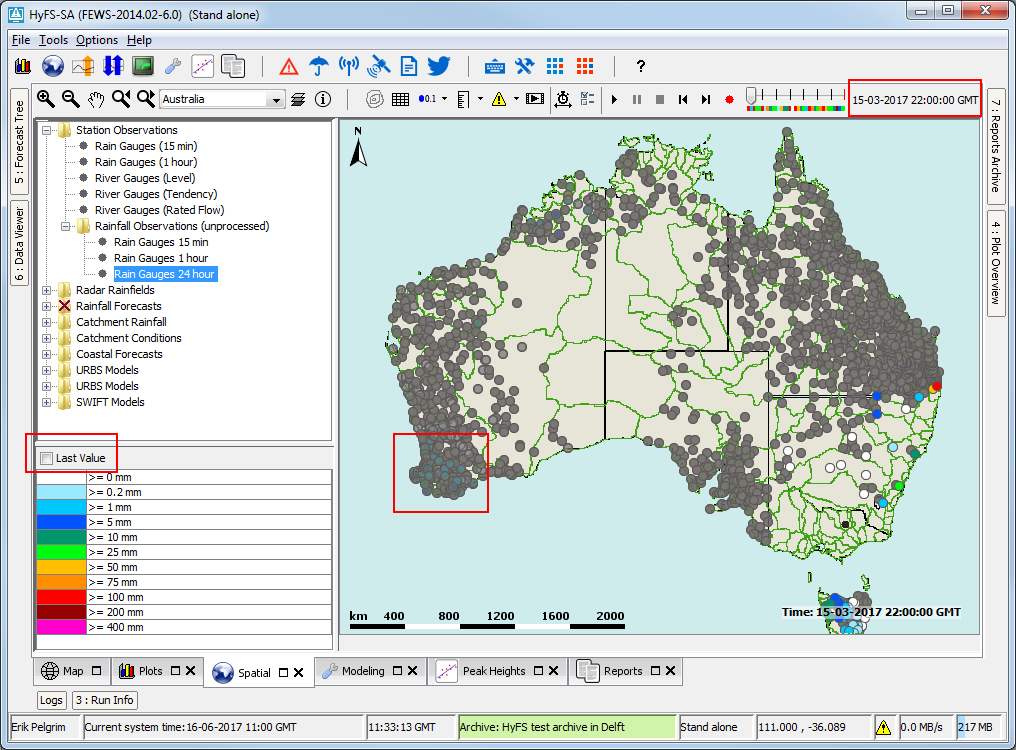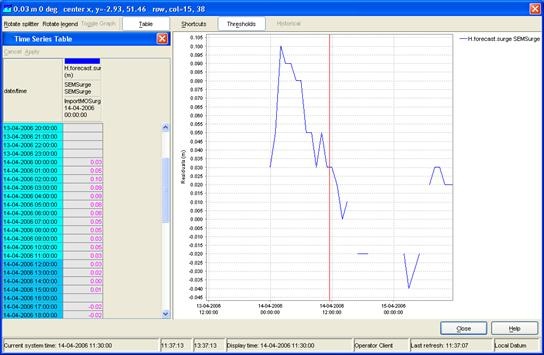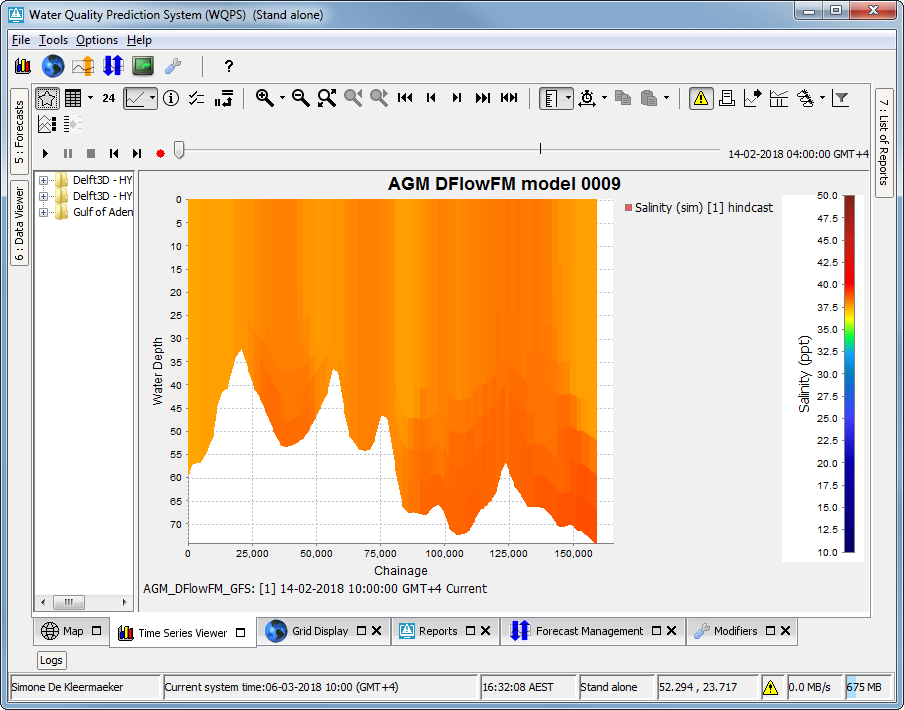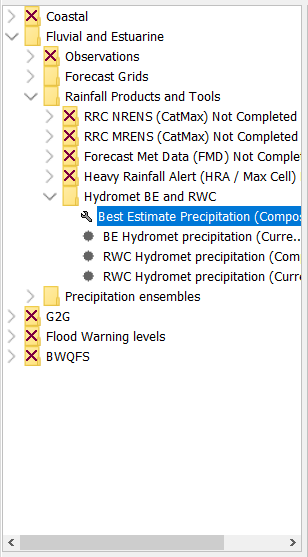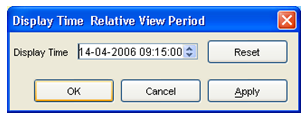Components of spatial display
Spatial Display
The Spatial Display grid display can be used to display time series of any type: scalar, polygon or grid (see figures below for examples). The display will depict the data on a map background. The display time is then set using a ruler that can be moved manually or made to move automatically.
The spatial display consists of following components:
- Spatial/grid/map display with configurable background layers
- Control Toolbar with following generic options:
- Zooming and panning
- Toggling on and off map layers or meta data, such as labels, values, flags, thresholds etc
- Time Slider Toolbar with the following generic options (located at the bottom of the map since 2019.02):
- Play, pause, stop, step forward, step backward and record buttons
- Time slider with time slice indicator
- Data availability and maximum value indicator (colours are in accordance with legend)
- Spatial Display selection filters (preconfigurable plots)
- Table or Bar Legend (with optional accumulation)
- Options to export or record data and time series
Control Toolbar
The toolbar provides the controls for displaying the spatial information via through the following buttons. The functionality of zoom options and layers is explained in the FEWS Explorer section (see chapter 2).
Button | Description |
|---|---|
| Contours. To turn on/off contour lines (regular grids configured with contour lines only). Numbers appear when the animation has stopped or paused. The colors, which indicate the value remain visible. | |
| Grid lines. Toggles grid or polygon lines on or off | |
| Product Info. Toggles product info on or off. (only shown if there are products present in the configuration, see the page on the Forecast Product Information Panel) | |
| Labels. Toggles labels on or off (drop down options include turning on/off locations, values and/or units in the labels and increasing /decreasing the number of decimals shown in the labels and tooltips) | |
| Value to local reference level. | |
| Flags. Switches to flags for selected time series / gridplot (quality, modifiers or thresholds) | |
| Search and select forecasts. Switches to (previous) forecasts. | |
| Show spatial thumbnails. Toggles thumbnails of each time step below the main spatial display on or off. | |
Show spatial ensemble thumbnails. Displays the ensemble thumbnails panel. | |
| Sketch mode buttons and other sketch drawing options. Switches the sketch mode between drawing points, adding points, drawing longitudinal profiles and drawing areas when the map is clicked. Contains additional options to save/load sketches and delete the current sketch. | |
| Options to show a graph based on current sketch. Drop-down menu with options to extract scalar time series, vertical profiles, longitudinal profiles, 2D longitudinal profiles, calculate budget and calculating the mean max min time series (for sketched areas). | |
| Activate spatial modifier mode. Toggles spatial modifier mode on or off (only shown if at least one spatial modifier is configured in ModifierTypes.xml). The additional modifier mode buttons shown when modifier mode is toggled on are explained in the spatial modifier section. | |
| Display time. Choose display time (period) | |
| Attributes. |
Time Slider Toolbar
Since 2019.02 the time slider and its buttons have been moved to a separate toolbar located at the bottom of the spatial display.
Play. Starts continuous play mode. The slider will indicate the time slice being shown. | |
Pause. Stops continuous play mode. The time slider remains at the time displayed at the moment. | |
Stop. Stops continuous play mode. The time reverts back to the start time. | |
One frame back. Moves the time slider back one timestep. | |
One frame forward. Moves the time slider forwards one timestep. | |
Record. Creates an AVI or animated gif movie file. The avi format is used by default unless the filename ends with '.gif'. After opening the file, the display will start playing from the current time position, until the stop button is clicked. | |
Time slider | The time slider can be dragged to specific time slice. |
Data availability | The data availability indicator provides a visual clue as to where you can find data. For those times where data is available, the colour of the data availability indicator will be set to the maximum value found in the data for that time slice. Note: For grids that contain horizontal flow data in the form of u,v vectors the data availability indicator might over-estimate the maximum values. In other words, for u,v vector data the availability indicator colours might indicate values greater than the actual maximum values found in the data. This is a known issue and was implemented to improve performance. |
Selection filters
The selection filters show which displays have been configured. Select a filter to display the data. Note that each grid display may be configured differently, i.e. with a different period of data to be displayed, with a different background map, etc. The configuration allows filters to be highlighted in bold.
Legend
The legend can be shown as table legend or as bar legend. The legend identifies the color used for each range of values. The range of values used for each color can be rescaled by right clicking on the display and selecting 'Rescale Classification' from the pop-up menu. The display colors will be updated to reflect the new classification. After rescaling, the lowest and highest values in the legend will correspond to the minimum and maximum values of the data in the current zoom extent of the display (for the selected time slice). When the display is zoomed in on an area where all data points or grid cells have similar colors, rescaling can be used to see more clearly the differences in the data values. To return to the default classification right click on the display and select 'Back To Default Classification' from the pop-up menu. When selecting a different plot, the classification always changes back to the default classification for that plot.
The user can change the classification colors by double clicking the colored squares in the table legend. These changes are stored in the user settings. If a user has made changes, they can be discarded by right clicking the display and selecting 'Discard User-Defined Classification Colors'.
When several classifications are configured, the user can select a classification through the drop down menu directly above the table legend.
A bar legend displays fluent scale bar as shown in the picture below:
Moving Average or Accumulation Slider
The moving average slider can be configured to allow the user to select a number of moving average settings. Each moving average window is then recalculated for the entire period.
Both the selected grid plot and the selected aggregation time step are stored in the user settings when closing. When reopening FEWS the same aggregation time step will be selected. When an aggregation time step has been selected and the user switches between different plots, FEWS will attempt to select the same time step again for the new plot.
Last Value Checkbox
When selected this checkbox shows the last available of time series configured in the grid plot. This can be useful when multiple timeseries with a different or non equidistant time step are defined within one grid plot and a time is selected where one time series does not have a time step. The time series can be scalar or grid. For scalars the last time step (that is still within the visible period) that does not have a missing value is shown, but for grids just the last time step is shown even though it can be a missing value. The checkbox will only appear when no accumulation or moving average slider has been configured, and can be hidden via configuration. The next screenshots show how data with a daily time step will appear at 22:00 even though it is not defined for that time:
Selecting different forecasts
Selecting different forecast times
Since 2019.02 a "search and select forecast" button is available: . This button is enabled if there is more than one forecast available, i.e. there are several forecast time series with different forecast times present in the database and the <numberOfRecentForecasts> is set to more than 1 for the selected grid plot. Click the button to cycle through the available forecasts. The drop-down menu will show the forecast times of the available forecasts and selecting one of these forecast times will show change the shown forecast to the one selected.
Alternatively the spatial thumbnails can be used to select different forecasts (and select different time steps). The spatial thumbnails panel will show one row for each forecast available. Toggle the panel on or off using the button.
Selecting different ensemble members
Available since 2019.02. The can be used to open the spatial ensemble thumbnails panel.
The spatial ensemble thumbnails window will open and show a thumbnail for each separate ensemble member at the selected time.
In this window the user can select the desired ensemble thumbnail to visualize this ensemble member in the grid display.
The ensemble member is specified at the bottom of the thumbnail and on the bottom right corner of the grid display.
The thumbnails can be resized at the bottom right corner of the first thumbnail, a resize mouse cursor will be show when hoovering over that corner.
The size will be stoed in the user settings afterwards.
Extracting data from the Spatial Display
Export time step data in ascii grid-file
By right clicking on the display, the grid data for a specific timestep can be exported in an ascii file. Select the desirable time step with the control toolbar.
Extracting scalar time series from grid
Scalar time series can be extracted from the grid by double clicking the point of interest. Depending on the type of data, which is displayed, the scalar time series will be relevant to either a point, polygon or grid cell. This can also be done in the following way. First select the point of interest by left clicking. A colored dot will be drawn to indicate the selected point. For grid data an additional green dot will be drawn to indicate the center of the selected grid cell (you may need to zoom in to see the green dot since it will be covered by the colored dot if they overlap). Extract the time series for the selected point either by selecting 'Show Time Series' from the drop-down menu of the button or by using the Ctrl+F3 shortcut.
Instead of immediately extracting the time series and showing the a time series dialog, the "Copy Time Series" option can be used to copy the time series for the selected point to the clipboard. Copied time series can then later be pasted in a time series dialog through the paste button in its tool bar.
Several points can be drawing by selecting the "Draw Points" sketch mode through the sketch mode button or holding the left ctrl and shift buttons while left clicking on the points of interest. When several points have been drawn, the "Show time Series" and "Copy Time Series" options will show/copy separate time series for each of the drawn points.
Instead of manually drawing a point / points, the 'Show Time Series For Coordinates...' option in the drop-down menu of the button can be used (shortcut: Ctrl+Shift+F3) which will open a small dialog prompting the user to enter coordinates of the point they wish to use.
A series, that is extracted from a grid, is not related to a known location or polygon ID. The series will then be identified using the grid coordinates.
The graph will automatically pop up with the time series of the selected point, polygon or grid cell. When animating the grid display, a marker will move over the time series graph as well.
To extract a different scalar time series double-click on another point of interest. This will draw a new dot and extract a scalar time series for that point. Please be aware that when extracting a scalar time series from a data point in the display, then the dot drawn on top of the data point has a different colour from the point itself. This way it may look like the data point has a different color because of the dot. The dot can be erased by selecting 'Delete Points' in the drop-down menu of the sketch mode button (or using the keyboard shortcut Ctrl+Delete).
Note:
Make sure that you stop the grid movie before you make a time series graph, this can cause the system to slow down because multiple processes have to be executed that take a lot of processing time.
Note:
Extraction of scalar time series is not available for rotated pole geodatum types. In some cases extraction of scalar time series can exhibit unexpected behaviour near the North Pole or South Pole.
Extracting vertical profiles from 3D data
When the spatial display is showing 3D (layered) data, a vertical profile can be extracted. A point should be drawn as described in the previous section, then select the 'Show Vertical Profile' option by right clicking or press Ctrl+F4 to show a time series dialog with the vertical profile for the drawn point. Alternatively a 'Show Vertical Profile For Coordinates...' option is available by right clicking or by pressing Ctrl+F5. The vertical profile will be shown as a line graph of the parameter versus the water depth. One can also create a vertcial profile with a color map by selecting the 'Use Color Map' option in the drop-down menu of the button or using Ctrl-M. The vertical profile will then be shown as a graph of water depth over time with the colors in the plot indicating the values of the selected parameter.
Extracting longitudinal profiles (Xsections) from a grid time series
Longitudinal profiles time series can be extracted from grid data and shown in a separate graph as well. The profile (or cross section) is defined by drawing a profile sketch. Start drawing a profile sketch either by opening the drop-down menu of the sketch mode button and selecting 'Start Drawing Profile' or by Ctrl+left clicking on the desired start point for the profile. A colored dot will be drawn to indicate the selected start point. Add additional line segments to the profile by left clicking in the display. Finish drawing by double-clicking on the desired end point for the profile. Green dots along the profile indicate which grid cells are used for the profile.
Once a profile sketch has been drawn, extract the profile either by selecting 'Show Longitudinal Profile' from the drop-down menu option by right clicking or by using the Ctrl+F2 shortcut. The graph of the profile will show automatically.
Instead of drawing the profile on the map, the 'Show Longitudinal Profile For Coordinates...' option can be used to enter coordinates for the profile points.
To extract a different profile just start drawing another profile. This will erase the previous sketch. The profile sketch can also be erased by selecting 'Delete Sketch' from the right-click drop-down menu.
When animating the grid, the profile follows the same animation. When animating the profile only, the grid animation remains fixed. Note that the same cross section can be reused when switching to another plot (Ctrl+F2 will open a new window).
Note:
Even more essential then for scalars, it is wise to pause the grid animation when dragging a cross section to be shown.
Note:
Extraction of longitudinal profiles is not available for irregular grids, points and polygons. The profile sketch will be erased when switching to a plot that contains data of one of these types. Extraction of longitudinal profiles is also not available for rotated pole geodatum types. In some cases extraction of longitudinal profiles can exhibit unexpected behaviour for profiles crossing the dateline or located near the North Pole or South Pole.
Note:
If longitudinal profile data is displayed in the spatial display, then there is no need to draw a profile sketch. Just press the F2 key or right click and select 'Show Profile' from the pop-up menu to show the graph of the profile.
Create 2D longitudinal profiles from data in the Spatial Display
Create a 2D longitudinal profile for 3D data a in the spatial display. A longitudinal profile should be drawn as described in the previous section. Open up the 2D longitudinal profile in the Time Series Display with Ctrl-F11, or by selecting the 'Show 2D Longitudinal Profile' option in the drop-down menu by right-clicking. There is also a 'Show 2D Longitudinal Profile For Coordinates...' option, to allow entering coordinates of the profile points instead of sketching the profile on the map.
Note, this feature only works for
- data within 1 grid partition. In some cases 3D data model runs are run on multiple domain partitions. This data can be shown as a 2D longitudinal profile, but only if the profile remains within a single domain.
- scalar data (e.g. Water temperature or salinity), and not yet for vector data like currents.
Extracting data for an area from a grid time series (Calculate Budget)
For certain types of data it is possible to extract time series data for a specific part of a grid and show this in a separate graph. This is only possible for scalar data with dimension "discharge" (L3/T), "volume" (L3), "velocity" (L/T), "length" (L) or "amountOfSubstance" and for horizontal flow data with dimension "discharge" (L3/T) or "velocity" (L/T). The dimension of a parameter group can be configured through the parameters.xml and a list of available dimensions can be found at Configuration Guide > Regional Configuration > Parameters.
The specific part of the grid is defined by drawing an area sketch (a closed polygon surrounding the desired area). Start drawing an area sketch either by selecting 'Start Drawing Area' from the drop-down menu of the sketch mode button and then left clicking the map, or by Shift+left clicking on the desired start point for the area. A colored dot will be drawn to indicate the selected point. Add additional line segments along the edge of the desired area by left clicking in the display. Finish drawing by double-clicking. The last point in the sketch will be connected to the first point automatically to create a closed polygon that surrounds the desired area.
Once an area sketch has been drawn, extract the desired data by selecting the 'Calculate Budget' option from the drop-down menu of the "use sketch button". The corresponding graph will show automatically. The 'Calculate Budget' option will perform one of the following calculations, depending on the type and the dimension of the selected data.
Grids that contain scalar data (e.g. water levels or rainfall data):
- For dimensions "discharge" (L3/T, e.g. flow in m3/s), "volume" (L3 e.g. volume in m3) and "amountOfSubstance"' the calculation will be 'volume summation'. This calculates the sum of the values inside the area. This uses all grid cells that are (partially) inside the area. The value of each grid cell is weighted using the fraction of the grid cell that is inside the area.
- For dimensions "velocity" (L/T, e.g. velocity in m/s) and "length" (L, e.g. water level in m) the calculation will be 'area times average level'. This calculates the average level inside the area multiplied by the size of the area. This uses all grid cells that are (partially) inside the area. The value of each grid cell is weighted using the fraction of the grid cell that is inside the area.
- If another dimension, or no dimension, is configured for the selected data, then the option 'Calculate Budget' is not enabled.
Grids that contain horizontal flow data in the form of u,v vectors:
- For dimension "discharge" (L3/T, e.g. flow in m3/s) the calculation will be 'mass balance horizontal flux'. This calculates the net horizontal flow into/out of the area. This uses all grid cells that are for at least 50% inside the area.
- For dimension "velocity" (L/T, e.g. velocity in m/s) the calculation will be 'mass balance horizontal velocity'. First for each grid cell the value of u, respectively v, is multiplied by the height of the gridcell, respectively the width of the grid cell, to get flow values (The height of the flowing water mass is taken to be 1). Then the net horizontal flow into/out of the area is calculated. This uses all grid cells that are for at least 50% inside the area.
- If another dimension, or no dimension, is configured for the selected data, then the option 'Calculate Budget' is not enabled.
If there is no parameter configured with one of the dimensions supported by the 'Calculate Budget' option, the option will be hidden.
To extract data for a different area just start drawing another area. This will erase the previous sketch. The area sketch can also be erased by selecting 'Delete Sketch' from the sketch drop-down menu (or pressing the keyboard shortcut "delete").
When animating the grid display, a marker will move over the time series graph as well. Note that the same area sketch can be reused when switching to another plot (right clicking and selecting one of the relevant options will open a new window).
Note:
Even more essential then for scalars, it is wise to pause the grid animation when dragging an area for extracting data.
Note:
Extraction of data for an area is not available for quadrilateral grids, irregular grids, and points. Extraction of data for an area is also not available for rotated pole geodatum types. In some cases extraction of data for an area can exhibit unexpected behaviour for areas crossing the dateline or located near the North Pole or South Pole.
Extracting min max and mean time series for an area
Available since 2019.02. An area should be drawn as described in the first paragraph of the previous section. Then select 'Show Min Max Mean Time Series For Area' in the drop-down menu of the button. A Time Series Dialog will show the expected time series.
Extracting data for multiple plots at once (available since build 18645)
It is possible to extract data for multiple plots at once. In the selection filters select a folder that contains more than one plot (as direct children). The first plot in the folder will be displayed. Then extract scalar time series, longitudinal profiles or data for an area in the usual way. The extracted data for all the plots in the selected folder will be shown in a combined diagram, where each plot has a separate graph.
Saving and loading sketches from shape files (available since build 18645)
Once a profile sketch or an area sketch has been drawn, the sketch can be saved as a shape file (*.shp file) by selecting 'Save Sketch As Shape File' in the drop-down menu of the sketch mode button (shortcut: Ctrl+Shift+S). A saved sketch or any other shape file that represents a profile or an area (a closed polygon) can be loaded into the display by selecting 'Load Sketch From Shape File' (shortcut: Ctrl+Shift+S). The loaded sketch can then be used for extracting data. When loading a sketch, the previous sketch will be erased.
Note:
A shape loaded from file will only be used as an area sketch (a closed polygon) if the first and last points of the shape have exactly the same coordinates. Otherwise the shape will be used as a profile sketch.
Creating Spatial Modifiers
In 2019.02 the first spatial modifiers were added. These modifiers are used to modify a grid time series and must be created through the Spatial Display instead of the Modifiers Panel.
Spatial Modifier Mode
To create spatial modifiers, the spatial modifier mode must be activated. To do so, first select the grid plot containing the time series you wish to modify, and then activate spatial modifier mode through the button. This button will only be visible if at least one spatial modifier is configured in the modifier types (See Configuration Guide > 04 Regional Configuration > 25 ModifierTypes). The button will only be enabled if the currently selected grid plot contains exactly one time series, for which a spatial modifier type is configured. Thus, this button is only available if it is actually possible to modify the currently visible time series.
To indicate which grid plot is currently being modified, i.e., the grid plot which was selected when modifier mode was activated, a wrench icon will appear in the tree and the tool-tip of the modifier mode button will show the name of the grid plot.
It is only possible to create spatial modifiers for the grid plot on which spatial modifier mode was activated. If you wish to change which plot you are modifying, spatial modifier mode must be deactivated (by clicking the button) and reactivated on the new grid plot.
When spatial modifier mode is activated, the spatial modifier button section will appear in the toolbar. This contains the following buttons.
Button | Description |
|---|---|
| Start time. Select the current time as new modifier start time. | |
| End time. Select the current time as new modifier end time. | |
| Clear period. Clear the selected new modifier period. | |
Copy modifier. Used when creating spatial copy modifiers. | |
| Paste modifier. Used when creating spatial copy modifiers. | |
| Spatial profile. Used to create a spatial profile modifier. |
When spatial modifier mode is activated the colors on the time slider will indicate the time periods on which modifiers are applied and the selected period for new modifiers (if any). The new modifier period will be shown in green. The color for the time steps on which a spatial modifier is active can be configured. In this example the configured color is black. It is also possible to configure ticks for the start and end time of the period of applied modifiers and start and end time of the selected new modifier period.
When spatial modifier mode is activated, the Modifiers Panel will show the modifiers for the grid plot being modified, instead of showing the modifiers for the selected forecast tree node. This is indicated by the title appearing directly above the table in the modifiers panel. When spatial modifier mode is deactivated, the modifiers panel will return to showing the modifiers for the selected forecast tree node.
When spatial modifier mode is activated, this is done "globally". This means that on any other spatial displays, spatial modifier mode will be active as well and for the same grid plot.
General Steps
This section explains the general steps necessary to create any spatial modifier. For any spatial modifier, the area on which the modifier is to be applied must be drawn and the time period for which the modifier should be applied must be selected. These steps can be done in any order.
Sketching the spatial modifier area
The area(s) on which a spatial modifier should be applied should be sketched using the sketch functionality of the spatial display. You can start drawing an area by selecting the "Draw Area" tool in the sketch button drop-down menu and left-clicking the map. Alternatively, you can hold the shift-key on the keyboard while left-clicking the map. Once you have started an area, left-clicking will result in a new point being added to the area border. Double clicking will finish the drawing by adding the double clicked point and closing the drawn polygon. Additional areas can then be drawn in a similar fashion. The drawn areas can be removed by using the "Delete Sketch" option in the sketch button drop-down menu or pressing the "Delete" key on the keyboard.
The current sketched areas will appear on the map with solid lines and point markers on each of the sketched border points:
Selecting the new modifier period
Each spatial modifier needs to be created for a certain time period. This period is set by selecting the start and end time of the period. Once a valid period has been selected, it will be marked green on the time slider. The selected start and end time will be marked with ticks if this has been configured.
To select the new modifier period, first select the time step you wish to use as the start or end time. Then the and buttons can be used to select the current time step as the new modifier period start or end time respectively. Alternatively, the time slider has been given a right-click menu which also contains these options:
The selected new modifier period can be cleared through the button or the "Clear the selected new modifier period" option in the right-click menu of the time slider.
Note that all options to select a new modifier period are only available when spatial modifier mode is active. If spatial modifier mode is deactivated, the new modifier period is cleared.
Creating a Spatial Copy Modifier
A spatial copy modifier takes the values of a different grid time series for a certain area and time period, and copies these values over the existing values in the modified time series. To create a spatial copy modifier, spatial modifier mode must be activated and an area and time period must be selected as explained in the sections above.
Select the grid plot you wish to copy the values from and use the button to copy a "potential spatial copy modifier" to the clipboard. When the button is clicked, the Spatial Display will take the area sketch, new modifier period and grid plot selected at the time the button is clicked and use this in the new "potential spatial copy modifier".
To actually create a spatial copy modifier the "potential spatial copy modifier" needs to be pasted into the grid plot being modified. To do so, select this grid plot and then click the button to paste the most recently copied information. The drop down menu of the button shows information on the most recent copy actions (up to five). Selecting one of the menu items in the drop down menu will paste that "potential spatial copy modifier".
It is possible to open two spatial displays side-by-side to be able to view the grid plot being modified as well as the time series you wish to use to copy values from. Note that to do so, the sketch and time period to be used should be selected in the same spatial display as you will use to select the time series you will copy values from and click the button.
When the paste button (or one of the drop-down menu items) is clicked, the spatial modifier creation dialog will be shown to set the general modifier properties and confirm the creation of the new modifier. The contents of this dialog are explained below.
Creating a Spatial Profile Modifier
A spatial profile modifier is created by defining an area, period and scalar time series with which the values in the grid cells within the area will be replaced. To create a spatial profile modifier, spatial modifier mode must be activated and an area and time period must be selected as explained in the sections above.
Select the "Spatial Profile"-button to make the spatial profile modifier dialog appear. This dialog is used to specify the scalar time series that will be used to replace the grid cell values. The time series can be edited through the table.
When the ok-button is pressed, the spatial modifier creation dialog will appear to set the general modifier properties and confirm the creation of the new modifiers. The contents of this dialog are explained below.
When an existing spatial profile modifier is selected in the modifier panel, the scalar time series can be edited. The selected area and period can not be edited.
Spatial Modifier Creation Dialog
When a spatial modifier is created, for example when the paste button is clicked to create a spatial copy modifier, the spatial modifier creation dialog is shown. This dialog allows the user to set the modifier properties like it's name and priority, and select the valid time they wish to use. In the top part of the dialog, the summary of the modifier that will be created is shown. This summary can't be edited, but it is selectable to allow copying parts of the summary when desired.
When the OK button is pressed, the spatial modifier will be created. A new uncommitted modifier will appear in the modifiers panel and the current sketch in the grid display will be deleted.
Modifier Properties
The modifier properties shown and set in the spatial modifier creation dialog are the same as the modifier properties that would be set through the modifiers panel for non-spatial modifiers. This includes the name, any user-defined description fields and the modifier priority. These properties can later be edited through the modifiers panel by selecting the modifier you wish to edit in the table.
Name
The name of the modifier. This field will be automatically filled with a summary of the modifier as a suggestion. It can contain at most 64 characters.
User Defined Description Fields
These can be configured in the modifier types. In the example shown above, there is one user defined description field configured called "Comment". These description fields can be used to allow users to add some additional information on the modifier they created.
Priority
The priority controls the order in which spatial modifiers are applied. This can be relevant if spatial modifiers have areas that overlap. For example, you may wish to create a spatial modifier for a large area, then modify a smaller subarea in a different way with a second spatial modifier. Modifiers are applied from the one with the highest value for priority to the one with the lowest value (so a modifier with priority 1 will be applied after a modifier with priority 2). This causes the modifier with the lowest value to be "on top". By default the priority is set to 1. In the previous example, you should set the priority of the modifier for the large area to a higher number, so the spatial modifier for the smaller area will appear on top (with default priority of 1). When two spatial modifiers have the same priority, there is no guarantee they will be applied in a certain order.
Validity
The validity options allow setting the forecast(s) a spatial modifier should be applied to. There are two options:
- Only valid for current forecast. If this option is selected, the newly created modifier will only be applied to the current forecast. Its valid time will be set to the forecast time of the current forecast.
- Always valid. If this option is selected, the newly created modifier will be applied to all forecasts (for the same time series). Its valid time will be left blank. This means the modifier will also be applied to previous forecasts and any new forecasts. Note that if the time period of the modifier falls outside the time period of a forecast, naturally applying the modifier will have no effect.
Viewing Existing Spatial Modifiers
When viewing a modified grid time series while spatial modifier mode is not active, the time slider will show colors to indicate the maximum value at a certain time step as usual, but these colors will be replaced by the configured "modifier color" to indicate at which time steps a modifier is applied. When hovering over the time slider on a time step where a modifier is applied, the tool-tip will show the names and any user defined descriptions of the applied modifiers.
When spatial modifier mode is activated, the time slider will no longer show the maximum value colors, but will still mark the periods on which modifiers are active with the "modifier color". When a time step is selected for which modifiers are active, the areas on which these modifiers are active will be shown on the map (with a dashed border). When hovering near the border of one of these areas, a tool-tip with the name and any user defined descriptions of this modifier will be shown and the area on which it is active will be highlighted.
Setting the display time
The display time in the spatial display can be changed in the standalone system only . The use is similar to the setting the display time in the data display, but with less modification possibilities.
When the display time is modified, the relative start and end times of the data to be shown are reset and the time slider is adjusted accordingly.
